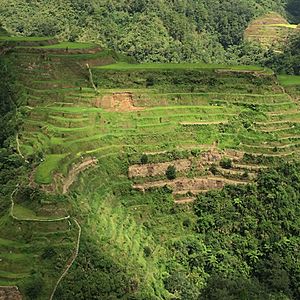Hudhud facts for kids
Quick facts for kids Hudhud chants of the Ifugao |
|
|---|---|
|
UNESCO Intangible Cultural Heritage
|
|

Banaue Rice Terraces, in Philippines
|
|
| Country | Philippines |
| Domains | Oral traditions and expressions Knowledge and practices concerning nature and the universe |
| Reference | 00015 |
| Region | Asia and the Pacific |
| Inscription history | |
| Inscription | 2008 (3rd session) |
| List | Representative |
 |
|
The Hudhud are special narrative songs from the Ifugao people. They live in the northern Philippine island of Luzón. The Ifugao region is famous for its amazing terraced rice fields in the mountains.
These songs are a very old tradition. People sing them during important times like planting and harvesting rice. They also sing them during funerals and other special ceremonies. The Hudhud songs might be even older than the seventh century! There are more than 200 different stories, and each story has about 40 parts. Singing a full Hudhud story can take several days.
What Makes Hudhud Special?
The Ifugao culture is unique because it is matrilineal. This means that the mother's family line is very important. In Hudhud stories, the wife often leads the singing. Her brother is sometimes even more important than her husband. This makes the Hudhud songs valuable for understanding the Ifugao way of life.
The language in these stories is very rich. It uses lots of descriptive words and repetitions. It also uses special language techniques like metonymies (using a related word for something), metaphors (comparing two unlike things), and onomatopoeias (words that sound like what they mean, like "buzz"). Because of this, it's very hard to write down the songs exactly. There are not many written versions of this tradition.
The Hudhud stories talk about ancient heroes and old religious beliefs. They also describe traditional practices and show how important rice farming is to the Ifugao people. The people who sing these stories, especially the older women, are very respected in their community. They are like priestesses and keepers of history. The Hudhud songs are sung by one main singer and then a group of people who sing along.
Keeping the Hudhud Alive
Over time, the Ifugao people started to become Catholic. This change made some of their old traditions, like the Hudhud, less common. Also, the Hudhud songs were often sung while people harvested rice by hand. Now, machines do a lot of this work.
The beautiful terraced rice fields are a World Heritage Site called "Terraced Rice Fields of the Philippine Ranges". But fewer and fewer people are becoming farmers. The last people who know all the Hudhud songs are getting very old. They need help to teach their knowledge to younger people.
Good news! With help from groups like the National Commission for Culture and the Arts (NCCA), more young Ifugao people are starting to appreciate the Hudhud today.
In 2008, UNESCO added the "Hudhud, sung accounts of the Ifugao" to its list of important Intangible Cultural Heritage of Humanity. This means it's a special tradition that needs to be protected.
To help keep the Hudhud tradition going, the Hudhud Perpetual Award was started in 2006. This award encourages people to sing the stories during harvests, funerals, and other important events in their towns.
Images for kids



